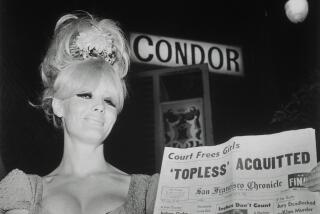TV REVIEW : An American Choreographer in Paris
- Share via
Although little known in her own country, Carolyn Carlson ranks among the most prominent American choreographers who have made their careers in Europe. Formerly a dancer in the Alwin Nikolais company, Carlson greatly influenced French modernism in stints at the Paris Opera in the last half of the 1970s and at Theatre de la Ville from the mid-’80s. In between, she served as choreographer-in-residence at La Fenice, Venice.
In the next several days, Bravo cable will telecast two separate programs on this 48-year-old, Oakland-born artist: the 90-minute, 1989 dance-drama “Dark” (Sunday at 8:30 p.m.) and the hourlong, 1986 documentary “Carolyn Carlson” (Wednesday at 7 p.m.). Each repeats twice during the month.
Directed by Andre S. Labarthe, “Carolyn Carlson” finds her preparing for a Venetian solo program, creating character dances based on a facets-of-woman premise. Directed by Torbjorn Ehrnvall, “Dark” offers a studio recording of an apocalyptic group piece, preceded by interviews that serve as program notes.
Lush production values dominate both her Venetian and Parisian projects, and this glamorous pictorialism--along with her emphasis on states of consciousness and penchant for neo-Expressionist Angst--makes these pieces utterly different from the kind of modern dance that Carlson’s contemporaries fashioned in America during this period.
Set in a poisoned world (gray earth, black grass), “Dark” remains obsessed with hair--the dancers continually lashing it, stroking it, wetting it--and Carlson herself turns up blond for the occasion (she has chestnut locks in the earlier program). Both telecasts reveal her as an eloquent dancer, superb in the use of her long arms for detailed expressive statements.
However, since each of her TV directors seems more interested in isolating his favorite Carlson moves than in documenting the moment-by-moment evolution of ideas in her choreography, it’s hard to become involved in these performances.
Labarthe keeps yanking us away from the dance studio for woozy home movies of Venice--plus shots of crabs. Ehrnvall seldom allows us to see the relationships between simultaneous actions, and his close-ups leave many of the dancers banished off-screen. Intriguing and valuable but also frustrating and ultimately inconclusive.
More to Read
The complete guide to home viewing
Get Screen Gab for everything about the TV shows and streaming movies everyone’s talking about.
You may occasionally receive promotional content from the Los Angeles Times.






